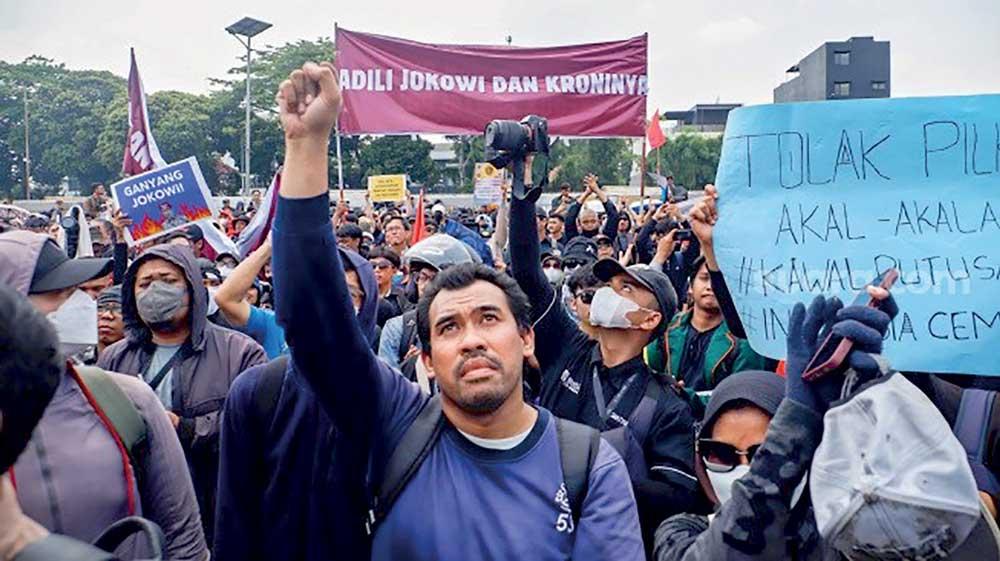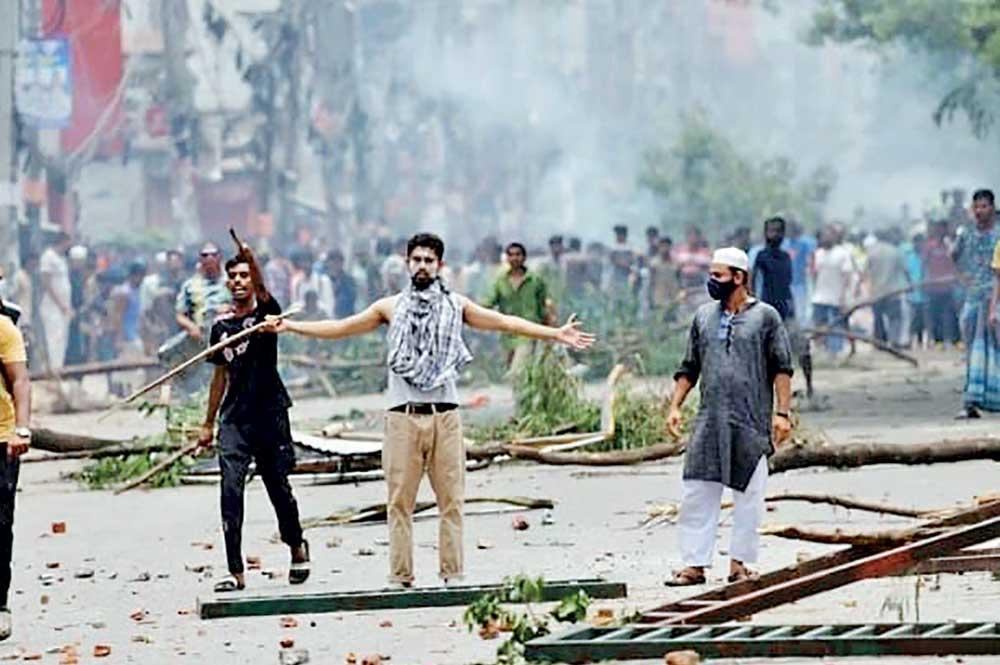Reply To:
Name - Reply Comment

Indonesia youth protesting in Jakarta on August 23
Photo © suara.com, Indonesia

Protestors in Dhaka, Bangladesha
|
One question that arises when analysing the mass movements of Sri Lanka, Bangladesh and Indonesia is, who exactly is behind these massive protests? Is it the Deep State, Fifth Estate or a combination? While the role of the Fourth Estate (the media) is to be the watchdog of the Executive, Legislature and Judiciary, it is captured by various interests; the Fifth Estate is now filling that space with new dynamics and momentum Are influencers or content creators part of this new Fifth Estate? Probably not so, given that the intention of influencers and content creators is monetising or generating advertising |
 First it was Sri Lanka, and then, after two years, the same sequence of events in Bangladesh. One can argue that, having learnt lessons from its neighbours, Indonesia avoided the calamity within days. But now, the Maldives is running out of dollars, and is on the verge of plunging into an economic crisis. This could well turn into the next big political crisis in Asia.
First it was Sri Lanka, and then, after two years, the same sequence of events in Bangladesh. One can argue that, having learnt lessons from its neighbours, Indonesia avoided the calamity within days. But now, the Maldives is running out of dollars, and is on the verge of plunging into an economic crisis. This could well turn into the next big political crisis in Asia.
The contexts for these crises may differ from one to another. In fact, it was in India, New Delhi to be exact, that we saw these kinds of mass protests for the first time. Yet, that was mainly confined to farmers. It did not expand to a multi-stakeholder movement, though it spanned many months. Indeed, the protestors could not make it a mass protest “by the people.”
Sri Lanka was different in 2022. The protests that year constituted a youth-led movement devoid of party politics – at least for the first three months. The objective was a regime change – or a system change – and after the fleeing of President Gotabaya Rajapaksa, a majority of protestors withdrew allowing a smooth transition of power. But, a few remained on, protesting, even as the transition regime came into power. They too were preparing to withdraw, when government forces attacked them. Though the objectives of these protests varied from group to group, the main aim was to get the ruling family out from the system, even though that did not happen in the long run. By August 2022, the protesters understood that their task had been completed, and let the democratic process of transition take its own course. They packed their bags and went home.
In Bangladesh, almost the same routine unfolded to a considerable extent. It didn’t extend for months like in Sri Lanka; it only took a few weeks. Frustrated students led the protest, ignited by a decision to reinstate a controversial quota system. But due to aggressive and brutal responses by the security forces, it turned into a massive protest movement against the government, which demanded the resignation of Prime Minister Sheikh Hasina. She fled the country. Yet protests continued, contrary to what happened in Sri Lanka. The result is that today, law and order is yet to be properly established in the country to pave the way for elections in less than two months. The caretaker government has yet to determine the modalities in conducting free and fair elections.
Two weeks back, similar developments were evident in another vibrant democracy in Asia – the third largest in the word, Indonesia. The protests this time around were against the dubious efforts of the outgoing President Joko Widodo to establish himself as the ghost ruler behind the scenes. Widodo had already succeeded in getting his elder son as the Vice-President, to the next government of Prabowo Subianto, from October. He also wanted the other son to be the Governor of Jakarta.
Jokowi moved the House to pass a law within 24 hours to overrun a decision by the constitutional court blocking his son from reaching up to the high post. Jokowi’s son-in-law was already running for the Governorship of Medan in North Sumatra, ensuring powerful positions for his family. At this point, the Indonesian youth decided that enough was enough. Thus, they got on to the streets. The protests that began within 24 hours quickly spread all over the Archipelago. The government, feeling the heat, and also taking a leaf from what had happened in Bangladesh, withdrew the controversial legislation and backed down to protestors. The country returned to normalcy.
One cardinal question when analysing these mass movements would be: who exactly is behind these massive protests?
There are two factors that normally get pointed at here. One is the Deep State, the other is the Fifth Estate. It could well be a combination of both.
Conspiracy theories often do make sense, one could easily argue, and when analysing these protests it would seem that such theories have a place. In this regard, Sri Lanka and Bangladesh appear to have many parallels. One could conclude there was a common architect in both power transitions, or to be more accurate, a number of common architects. For instance, the political calamities in the Maldives, in the aftermath of a massive economic crisis, can be logged into a conspiracy theory of Male being or rather getting close to China. Similarly, Sheikh Hasina’s visit to China in the backdrop of the country’s economic downfall took place immediately prior to the protests. Moreover, some could argue that Jokowi’s decision to limit the selling of mining raw materials to US linked companies and to give an initiative for the country to start its own companies to produce goods using these raw materials would have attracted the ire of the West. There are also conspiracy theories around Muslim leaders critical of Israel who have been supposedly singled out for removal from power.
Leaving aside the Deep State, there is also the Fifth Estate, but what is Fifth Estate? According to new academic theories the Fifth State represents the networked civic minded individuals who, through the internet in particular, mobilise the masses in the cause of good governance. The role of the Fourth Estate (the media) is to be the watchdog of the other three, the Executive, the Legislature and the Judiciary, in a democratic space. But as the Fourth Estate is heavily captured by various interests, both political and commercial, the desired watchdog role is absent, compromised or entirely neglected. The Fifth Estate is now filling that space with new dynamics and momentum.
In fact, the emergence of the internet has enabled like-minded civic conscious individuals to connect with each other and mobilise the masses for their cause in little to no time. Moreover, the Fifth Estate enables accountability at the individual level and has also threatened the highly politicised democratic institutions. What this means is that the Fifth Estate is now rapidly shifting institutions to individuals who are networked through the internet. This is the argument of William H. Dutton, a prominent academic in Oxford who has written extensively on the subject. It is something Manuel Castell predicted 28 years ago in his groundbreaking publication ‘The Rise of Network Society’ (1996).
We have seen the power of this Fifth Estate in all mass uprisings in Sri Lanka, Bangladesh and Indonesia. Last week, I talked to many informed individuals in Jakarta to understand the dynamics of the protest which took place a week before. However, no one could understand the real identity of the persons behind the movement. “No, it was not even an organised mechanism to be called a movement. Those were youth, I would say the civic minded youth of Gen Z who wanted authoritarianism defeated and democracy protected at any cost,” a key media person told me. Certainly, the mobilisation was so quick, within a matter of hours, that the centre was flooded with protestors, he added. Had the situation continued for another 48 hours, Indonesia would well have resembled Bangladesh.
It is clear that, in this digital age, conventional establishments are becoming de-institutionalised and their social functions are being transferred to civic minded and networked individuals – the Fifth Estate.
In that regard, are influencers or content creators part of this new Fifth Estate?
This is probably not so, given that the intention of influencers and content creators is monetising or generating advertising. They are, in fact, part of the Fourth Estate. The Fifth is entirely pivoted on public interest and nothing else. But at the same time, political interests can make use of the opportunities created by the Fifth Estate. Yet that is natural in a functioning democracy. Nevertheless, the functioning of the Fifth Estate will continue as a strong, institutionally weak but functionally watchdog and strong pillar. Just think of social media, blogs, and citizen journalism. These are not stable institutions, yet they are extremely strong in opinion making, changing perceptions and mobilising the public.
At the same time, the Fourth Estate (that is, the legacy media) will also continue through the practice of conventional journalism. But it will continue to fail in setting the agenda for society as it has been heavily captured and compromised in various forms by various interests. In that sense, the struggle for Press Freedom will mainly continue at the level of civil society.
Another dynamic in this new democratic landscape is the fear that the Fifth Estate has compelled in governments. That is what we have clearly noticed in Indonesia. Governments, however powerful they may be, are extremely careful in dealing with this new pillar of concerned citizenry. They want to regulate it, bring laws to manipulate or control it, but to no avail. In fact, they are confused about the kind of response they should mount, as this has morphed into a battle between old systems and digital globalisation, a new landscape that has effectively killed national borders.
Many governments are trying various means to curb or control the Fifth Estate. Some are experimenting with the Chinese Great FireWall to monitor the communications of every individual. They are trying to pressurise Big Techs to cooperate with them to control the content, but to no avail. When it comes to the most critical point, the only available tool would be internet shutdowns or social media blocks. Yet, these are counterproductive in terms of the economy and social functioning of a country.
Here, the million-dollar question would be whether the Deep State and the Fifth Estate can work hand-in-hand vis-à-vis public uprisings. The very nature of the Fifth Estate would preempt this at the outset, but we cannot rule out such possibilities. In any case, if the Deep State and Fifth Estate do work hand-in-glove, the Deep State would be hidden far behind, and its involvement would remain limited, at best, to conspiracy theories.
There is no doubt that we need new systems and procedures that go beyond national borders in addressing these issues. The thinking of contemporary governments is, as of today, in-line with the needs of an industrial revolution era. But the real issues have leapfrogged to the information revolution era. The power of the Fifth Estate ultimately resides in people. It fundamentally represents the power of people. And this power has come to be entirely fueled by the possibilities of the internet.
Dr. Ranga Kalansooriya is the Co-Founder/Chair of Factum, a Colombo based think-tank on international relations and tech cooperation. He can be reached at: [email protected]